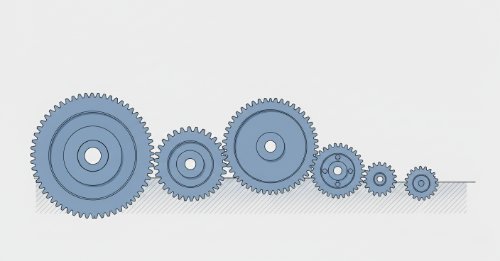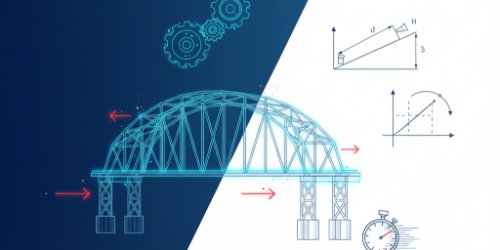Kinematics of Particles - Engineering Mechanics (Undergraduate Advanced)
214
59 hrs
 MEE 206: Engineering Mechanics - DynamicsMaster the principles governing the motion of engineering systems. This learning track provides a complete education in dynamics, systematically building from the kinematics of particles to the kinetics of rigid bodies and culminating in an introduction to dynamic systems and vibration. You will learn to analyse and predict how mechanical systems behave under the influence of forces.
This programme is for undergraduate students in mechanical, aerospace, civil, or related engineering disciplines. It is also essential for practising engineers and applied scientists who require a rigorous, first-principles command of dynamic analysis for their professional work. A prerequisite knowledge of statics, calculus, and vector algebra is assumed.
Upon completion, you will possess the analytical tools to solve complex dynamics problems for particles and rigid bodies using force, energy, and momentum methods. This provides the essential foundation for advanced study in mechanical design, control systems, and structural analysis, and prepares you for demanding technical roles in the engineering sector.
MEE 206: Engineering Mechanics - DynamicsMaster the principles governing the motion of engineering systems. This learning track provides a complete education in dynamics, systematically building from the kinematics of particles to the kinetics of rigid bodies and culminating in an introduction to dynamic systems and vibration. You will learn to analyse and predict how mechanical systems behave under the influence of forces.
This programme is for undergraduate students in mechanical, aerospace, civil, or related engineering disciplines. It is also essential for practising engineers and applied scientists who require a rigorous, first-principles command of dynamic analysis for their professional work. A prerequisite knowledge of statics, calculus, and vector algebra is assumed.
Upon completion, you will possess the analytical tools to solve complex dynamics problems for particles and rigid bodies using force, energy, and momentum methods. This provides the essential foundation for advanced study in mechanical design, control systems, and structural analysis, and prepares you for demanding technical roles in the engineering sector.
Master the principles governing the motion of engineering systems. This learning track provides a complete education in dynamics, systematically building from the kinematics of particles to the kinetics of rigid bodies and culminating in an introduction to dynamic systems and vibration. You will learn to analyse and predict how mechanical systems behave under the influence of forces. This programme is for undergraduate students in mechanical, aerospace, civil, or related engineering disciplines. It is also essential for practising engineers and applied scientists who require a rigorous, first-principles command of dynamic analysis for their professional work. A prerequisite knowledge of statics, calculus, and vector algebra is assumed. Upon completion, you will possess the analytical tools to solve complex dynamics problems for particles and rigid bodies using force, energy, and momentum methods. This provides the essential foundation for advanced study in mechanical design, control systems, and structural analysis, and prepares you for demanding technical roles in the engineering sector.
 GET 207: Applied MechanicsMaster the non-negotiable principles of Engineering Mechanics. This track delivers a rigorous, complete programme in statics and dynamics, built to the NUC GET 207 core curriculum. It moves methodically from force systems and equilibrium to the kinematics of rigid bodies and the kinetics of particles. This is the foundation of all structural and mechanical analysis.
This programme is for first and second-year undergraduate engineering students. It is an essential requirement for students in Mechanical, Civil, Structural, Aerospace, and Mechatronics engineering. A working knowledge of introductory physics and calculus is assumed.
On completion, you will be able to analyse and solve complex problems in statics and particle dynamics. You will draw free-body diagrams, apply equilibrium equations, analyse trusses and frames, and solve motion problems using Newton's laws, work-energy, and momentum methods. This programme prepares you for advanced courses, particularly Mechanics of Materials, and future professional engineering practice.
GET 207: Applied MechanicsMaster the non-negotiable principles of Engineering Mechanics. This track delivers a rigorous, complete programme in statics and dynamics, built to the NUC GET 207 core curriculum. It moves methodically from force systems and equilibrium to the kinematics of rigid bodies and the kinetics of particles. This is the foundation of all structural and mechanical analysis.
This programme is for first and second-year undergraduate engineering students. It is an essential requirement for students in Mechanical, Civil, Structural, Aerospace, and Mechatronics engineering. A working knowledge of introductory physics and calculus is assumed.
On completion, you will be able to analyse and solve complex problems in statics and particle dynamics. You will draw free-body diagrams, apply equilibrium equations, analyse trusses and frames, and solve motion problems using Newton's laws, work-energy, and momentum methods. This programme prepares you for advanced courses, particularly Mechanics of Materials, and future professional engineering practice.
Master the non-negotiable principles of Engineering Mechanics. This track delivers a rigorous, complete programme in statics and dynamics, built to the NUC GET 207 core curriculum. It moves methodically from force systems and equilibrium to the kinematics of rigid bodies and the kinetics of particles. This is the foundation of all structural and mechanical analysis. This programme is for first and second-year undergraduate engineering students. It is an essential requirement for students in Mechanical, Civil, Structural, Aerospace, and Mechatronics engineering. A working knowledge of introductory physics and calculus is assumed. On completion, you will be able to analyse and solve complex problems in statics and particle dynamics. You will draw free-body diagrams, apply equilibrium equations, analyse trusses and frames, and solve motion problems using Newton's laws, work-energy, and momentum methods. This programme prepares you for advanced courses, particularly Mechanics of Materials, and future professional engineering practice.
Course Chapters
1. Introduction13
Meaning of mechanics, dynamics, kinematics, kinetics and other terms; general problem solution method; units of measurement.
Chapter lessons
1-1. Mechanics24:29
1-6. Particles and rigid bodies20:29
1-7. Fundamental principles I1:12:45
1-8. Fundamental principles II26:32
1-9. Fundamental principles III14:52
1-10. Systems of unit27:18
1-12. Numerical and symbolic solutions6:40
2. General Rectilinear Motion412
Analysis of rectilinear motion with variable acceleration.
Chapter lessons
2-1. Introduction30:29
2-2. Velocity35:09
2-3. Acceleration27:44
2-4. Procedure29:08
3. Special Rectilinear Motion (1)24
Analysis of rectilinear motion with constant acceleration - uniform motion and uniformly-accelerated motion.
Chapter lessons
3-1. Uniform acceleration32:04
Meaning of uniformly-accelerated motion and its implications.
3-2. Uniform velocity8:24
Meaning of uniform motion and its implications.
4. Special Rectilinear Motion (2)36
Analysis of relative independent motion of particles, and absolute and relative dependent motion of connected (or constrained) particles.
Chapter lessons
4-1. Relative motion34:18
Relative position, velocity and acceleration for two particles in rectilinear motion.
4-2. Dependent motion (1)35:52
Dependent motion of connected bodies and how to relate their positions, velocities and accelerations when the connecting cable(s) is (are) aligned with the direction(s) of motion of the bodies.
4-3. Dependent motion (2)47:10
Dependent motion of connected bodies and how to relate their positions, velocities and accelerations when the connecting cable(s) is (are) not aligned with the direction(s) of motion of the bodies.
5. Graphical Analysis14
Analysis of erratic rectilinear motion problems using graphs relating the motion parameters.
Chapter lessons
5-1. Erratic motion31:29
Meaning of erratic motion and its implications.
6. Curvilinear Motion (1)314
Analysis of the curvilinear motion of particles using rectangular (Cartesian) coordinates.
Chapter lessons
6-1. Curvilinear motion35:20
Meaning of curvilinear motion; general definitions of position, displacement, velocity and acceleration for a particle undergoing curvilinear motion.
6-2. Rectangular components20:58
Definitions of position, velocity and acceleration of a particle in curvilinear motion using the Cartesian coordinate system.
6-3. Projectile motion38:13
Application of the concepts of rectangular components for curvilinear motion to problems of projectile motion.
7. Curvilinear Motion (2)17
Analysis of the curvilinear motion of particles using components normal and tangential to the trajectory of motion.
Chapter lessons
7-1. Normal and tangential components1:27:25
Position, speed, velocity, acceleration and radius of curvature of the trajectory of a particle in curvilinear motion, using components normal and tangential to the trajectory.
8. Curvilinear Motion (3)110
Analysis of the curvilinear motion of particles using radial and transverse components.
Chapter lessons
8-1. Radial and transverse components34:36
Position, displacement, velocity and acceleration of a particle in curvilinear motion, using radial and transverse (polar) components.